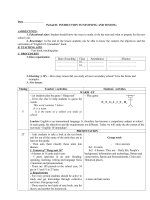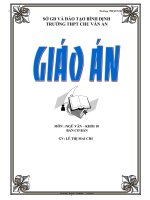English 10- Period 1 &2 - New
Bạn đang xem bản rút gọn của tài liệu. Xem và tải ngay bản đầy đủ của tài liệu tại đây (140.67 KB, 5 trang )
Date...............................
Period 01: INSTRUCTION TO STUDYING AND TESTING
A.OBJECTIVES:
1. Educational aims: Student should know the ways to study, to do the tests and what to prepare for the new
school year.
2. Knowledge: At the end of the lesson students can be able to know the content, the objectives and the
curriculum of “English 10- Immediate” book.
B. TEACHING AIDS:
Text book, teaching plan
C. PROCEDURES
1.Class organization:
2.Checking :( 10’) – How many tenses did you study at lower-secondary school? Give the forms and
examples.
3. New lesson:
Timing Teacher
’
s activities Students
’
activities
5’
WARM -UP
- Let students play the game “ Hang man”
- Gives the clue to help students to guess the
words.
This word contains 7 letters
It is a noun
It is the name of a subject you study at school
- Play game
E_ N_ G_L _I _S _ H_
Lead-in: English is an international language. It, therefore has become a compulsory subject at school . In
each grade, the objectives and the requirements are different. Today we will study the the conten of the
tect book “ English 10-immediate”.
PRESENTATION
25’
- Asks students to take a look at the text book
and list out all the name of the units they are to
learn at this grade.
- Then asks them classify these units into
themes.
1. Content of “Tieng anh 10”
- 6 themes in 16 units and 6 tests
- 5 parts (periods) in an unit: Reading,
speaking, listening, writing and language focus
( Grammar and pronunciation)
- There are 105 periods in the school year, 54
per in 1
st
and 51 in 2
nd
term
2. Requirements
- For every period students should be active to
study and get knowledge through collective
Group work
- Give answers
Ss1: 16 units
Ss2: 6 themes. They are: - Daily life, People’s
background, Information and technology, Nature and
conservation, Sports and Entertainments, Cities and
Historical places.
- Listen and take notice
Date of teaching Class Attendances Absence
………………….
…………………
10.......
10.......
.....................
......................
…………………………..
…………………………..
activities: Pair/group work.
- There must be two kinds of note book: one for
theory and another for homework.
- Test yourself (after 2 or 3 units) must be done
Timing Teacher
’
s activities Students
’
activities
by students at home.
- Checking homework will be done during the
period not only at the beginning.
- There will be there skills (reading, listening,
and writing) and linguistic items in a test.
4. Consolidation (3’)
- Summaries the main points of the lesson
5. Home work (2’)
- Prepare for new lesson- Unit 1: A day in the life of.... Part A- Reading
Date................................
Period: 02 Unit 1: A day in the life of...
Lesson 1: Reading
---------------
A. OBJECTIVES
1. Educational aims: Students should sympathy with the hard of farmer’s life.
2. Knowledge:
+ General knowledge: After the lesson students will be able to:
- Guess the meaning of the words from the contexts
- Understand the passage and complete all the tasks of the lesson.
+ Language item: Using vocabulary related to the topic correctly to talk about routine
3. Skills: Develop such micro-reading skills as skimming for main ideas, reading comprehension and
guessing meaning in contexts.
B. TEACHING AIDS
- Teaching plan, text book, pictures and color chalks
C. PROCEDURES
1. Class organization.
2. Checking: (During the lesson)
3. New lesson
Timing Teacher
’
s activities Students
’
activities
5
WARM-UP
- Hangs a picture of a farmer working on the
field on the board, and then asks some
questions.
+ What can you see in this picture?
+ What is the farmer doing?
+ Where is he working now?
+ Is his work hard or easy?
Whole class work
- Look at the picture and answer teacher's questions.
+ There is a farmer and a buffalo
+ He is ploughing.
+ He is working on the field.
+ I think his work is hard.
Lead-in:
BEFORE YOU READ
7
Activity 1 : Making conservation on daily
routine.
- Asks students to work in pairs, asking and
answering questions about their daily work.
-Eg:
What time do you often get up?
go to school
Pair work:
- Ask and answer
- Some pairs practise loudly.
E.g. Lan: Hello, Hoa.
Hoa: Hi, Lan. Where are you going?
Lan: I am going to school.
Hoa: Oh, so early. What time do you often get up?
Lan: I often get up at 5 o’clock. And you?
Date of teaching Class Attendances Absence
………………….
…………………
10.......
10.......
.....................
......................
…………………………..
…………………………..
- Walks round to help.
- Check up.
Activity 2:
- Asks students to look at the pictures and list
out the work a farmer often do in their daily life.
...........
Group work harvest
Plough harrow
Timing Teacher
’
s activities Students
’
activities
WHILE YOU READ
Activity 1 : (4’)
- Asks students to read silently the whole text in
4 min, underline and try to guess meaning of
new words. If not, T can explain for them.
*Task 1: Choose the best answers (6’)
- Asks students to read the text again and do the
task individually at first. To facilitate students,
T might give them some techniques to do the
task.
- Then, lets students exchange the answers with
their partners for peer correction
- T gives feedback
*Task 2: Answer the questions (10’)
Activity 2 :
- Asks students to read through all the questions
in the task, and then ask them to underline the
important words.
- Lets students read again the text to find the
answers
Activity 3 :
- Asks students to work in pairs to ask and
answer these questions without reading in their
books (look up and say only)
- Correct mistakes if necessary.
Individual and group work
- Read the text silently and discuss the new words in
group.
- Underline the new words and structures to asking
teacher for explanation.
Vocabulary and structures
- get up
- peasant
- fellow
- pump
- wake sb up
- lead the buffalo to the field
Individual and pair work
- Read and choose suitable words.
- Share the result in pairs
- Some students give answers:
1. rings
2. to prepare
3. talk in a friendly way
4. satisfied with
Individual work
- Read the questions and finds the answers
Pair work
- Do as required, other pairs listen and compare the
result.
1. He’s a farmer/ peasant.
2. He gets up at 4:30 and then he goes down to the
kitchen to boil some water for his morning tea.
3. In the morning he ploughs and harrows his plot of
land drinks and smokes his local tobacco during his
break.
4. In the afternoon, they repair the banks of the......
5. s
AFTER YOU READ
- Tells students to work in groups to discuss Mr.
Vy and Mrs. Tuyet’s daily routines
- Asks some representatives to speak out the
ideas of their groups.
-Ask students to summarize the reading passage.
- Give remark and correction.
Group work
.
.
Farmer’s
works
4. Consolidation (3) - Summaries the main points of the lesson
5. Home work (2’)
- Write a passage about your parents’ daily routines (about 100 words).









